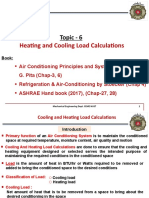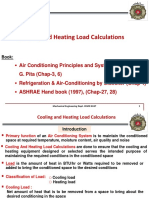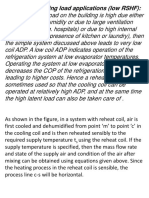Heating Loads
Uploaded by
wasoncefree123Heating Loads
Uploaded by
wasoncefree1231.
Introduction
Spaces in buildings need to be conditioned or maintained at certain conditions depending upon
climatic factors and requirement. This is done by HVAC systems. In order to be able to design
large scale HVAC systems, an understanding of the thermodynamic principles underlying such
systems is important. A very basic component of HVAC design parameters is the Heating Load.
Heating Load is defined as the amount of heat that must be supplied to keep the building or room
air at the desired temperature. The heating load requirements for buildings result from two types
of heat losses: heat transfer losses and infiltration/ventilation losses.
Determining the Heating Load is crucial in the selection of the heating equipment, piping and
duct sizing, and in energy utilization studies. Accuracy of heating load determination is
fundamental since inaccurate calculations result in unsatisfactory indoor air conditions and
increased energy costs. This is done in accordance with codes established by States and agencies
that now require accurate heating and cooling load calculation methods.
1.1 Principle of Heat Load Calculations
The air temperature of the space depends on its enthalpy. If the air enthalpy decreases, its
temperature decreases. Temperature decrease mainly occurs by heat transfer from the warm
inside air to the cold outside air through walls. windows, and other parts of the building envelope
and leakage or infiltration of cold air through openings in the building. For the air to remain at a
constant elevated temperature, the enthalpy must also remain constant. If the room air enthalpy is
to be maintained at a constant desired value, heat must be continually added to the interior of the
building to equal the heat losses from the room. Heat losses from a building or control space are
to be calculated; then this information can be used to determine the required capacity of the
heating equipment.
1.2 Overall Heat Transfer Coefficient (U)
For each application, the designer can calculate the overall thermal resistance for each part of the
building structure through which heat flows, but fortunately, these calculations have already been
made for many different combinations of building materials.
Overall resistance values are available, as overall conductance, called the overall heat transfer
coefficient (U), BTU/hr-ft
2
-F. The relationship between R
o
and U is U=R
o
In terms of V, the heat
transfer equation then becomes
Q = UxAxT
D
(1)
where,
Q = heat transfer rate, BTU/hr
V = overall heat transfer coefficient, BTU/hr-ft
2
-F
A = surface area through which heat flows,ft
2
T
D
= temperature difference, F
Overall V-values for some combinations of building components are available from references.
V-values for roofs, walls, floors, partitions, and doors. Literature is available for use, depending
on which one matches the construction assembly in the case encountered. There is a slight
difference in V-values between winter and summer. This is because the R-values of the outside
air film coefficients used in finding the V-values are based on a 15 MPH wind in winter and 7.5
MPH wind in summer. The summer U:values are used in cooling load calculations. The V-values
also include the effect of the window or door frame (also called sash, with windows). When V-
value tables do not include the appropriate construction, it should be calculated by adding the
individual resistances.
1.3 Heat Transfer
Overall thermal resistance can be calculated for each part of the building structure through which
heat losses occur. Such calculations for many different combinations of building materials are
readily available in literature as overall heat transfer coefficients.
1.4 U-values and Energy Standards
State energy codes and standards attempt to limit the amount of energy used by HVAC systems.
One way of doing this is to prescribe maximum allowable V-values (and minimum Ro values).
The degree day is a number that reflects the length and severity of a heating season. For an actual
building, of course, the designers would refer to the applicable real energy code or standard.
2. Heat Transfer Losses: Basement Walls And Floors
The Equation 1 is used to calculate the heat losses through basement walls and floors. Depending
on whether the part of the basement is above the ground or below the ground, relevant U-values
are used from literature. The inside and outside design air temperatures are also used to find T
O
.
This is due to the effect of the surrounding ground on the thermal resistance and the heat flow
path. T
o
find the T
o
for the below grade wall or floor, the outside winter design temperature is
taken to be the deep ground temperature value. This temperature varies between about 40 F and
60 F in cold climates.
2.1 Basement Inside Temperature
A number of possible conditions may exist in a basement.
1. Basement heated by terminal units : The basement heat losses should be calculated using
the basement inside design temperature. If the basement is partitioned, a separate
calculation for each area is required.
2. Unheated basement: The temperature in an unheated basement (with no heat sources) will
be between the design inside and design outside temperatures. No heat loss calculation
from the basement should be made.
3. Basement heated by heat source equipment: This situation exists when the furnace and
ducts or boiler and piping are located in the basement. The following guidelines are
recommended:
For any area that the heat source is in or substantial hot ducts or piping pass through,
assume the inside temperature is equal to that of the rest of the building, and calculate
the resulting heat transfer loss.
For other partitioned off areas, assume an unheated basement. In items 2 and 3b. there
will still be a heat loss from the floor above which should be added to the heat losses
from those rooms. If the specific basement conditions are not known, an estimated
unheated basement temperature of 50 F should be used. (A temperature below this
should not be permitted anyway, because of the possibility of freezing water in
piping.)
3. Heat Transfer Losses: Floor On Ground And Floor Over
Crawl Space
Special calculations apply for the heat transfer which occurs through a concrete floor slab on
grade and through a floor with a crawl space below.
3.1 Floor Over Crawl Space
If the crawl space is vented during the heating season (to prevent moisture condensation). The
crawl space air temperature will equal the outside air design temperature. The heat loss through
the floor area should be calculated. In cold climates, the floor should be insulated; an overall R-
20 value is a typical requirement in state energy codes. If the crawl space is used for the warm air
heating ductwork, the heat loss calculation is more complicated and has to be done using the
ASHRAE Handbook or local energy codes.
3.2 Floor Slab on Grade
When a floor is on the ground, the heat loss is greatest near the outside edges (perimeter) of the
building and is proportional to the length of these edges, rather than the area of the floor. This is
the only case where heat transfer is not calculated using Equation 1. The following equation is
used instead:
Q=ExLxT
D
(2)
where
Q = heat transfer loss through floor on grade, BTU/hr
E = edge heat loss coefficient, BTU/hr-F per ft of edge length
L = total length of outside (exposed) edges of floor, ft
T
D
= design temperature difference between inside an d outside air, F
The values of E for various wall constructions, both with and without edge insulation are
obtained from literature. Insulation is usually required by energy codes. The last entry applies to
a heated floor slab, which is recommended in more severe winter climates. The edge loss method
is recommended for buildings with small floor slab areas.
For buildings with large floor slab areas, the edge loss method is recommended only for
perimeter rooms. For the interior areas, Equation 1 should be used, with the U and TD values for
basements.
4. Infiltration And Ventilation Heat Loss
In addition to the heat required to offset heat transfer losses in winter, heat is also required to
offset the effects from -any cold outdoor air that may enter a building. The two means by which
cold air may enter the building are called infiltration and ventilation. The resulting amounts of
heat required are called the infiltration heating load and the ventilation heating load.
4.1 Sensible Heat Loss Effect of Infiltration Air
Infiltration occurs when outdoor air enters through building openings, due to wind pressure. The
openings of most concern to us are cracks around window sashes and door edges, and open
doors. Infiltration air entering a space in winter would lower the room air temperature.
Therefore, heat must be furnished to the room to overcome this effect. This heat is in addition to
the heat required to offset the heat transfer losses. The amount of heat required to offset the
sensible heat loss from infiltrating air can be determined from the sensible heat equation.
Q
s
= mxcxT
C
(3)
where
Q
s
=heat required to warm cold outdoor air to room temperature, BTU/hr
m =weight flow rate of outdoor air infiltration, lb/hr
c =specific heat of air, BTU/lb-F
T
C
=temperature change between indoor and outdoor air, F
The weight-flow rate of air (m) is expressed in Ib/hr. However, air flow rates in HVAC work are
usually measured in ft3/min(CFM). If the units are converted, using the appropriate specific heat
of air, the sensible heat equation is
Q
s
= 1.1xCFM x T
C
(4)
where
Q
s
= sensible heat loss from infiltration or ventilation air, BTU/hr
CFM =air infiltration (or ventilation) flow rate, ft3/min
T
c
=temperature change between indoor and outdoor air, F
4.2 Latent Heat Loss Effect of Infiltration Air
Since infiltration air is often less humid than the room air, the room air humidity may fall to an
unacceptable level for comfort. If the room air humidity is to be maintained, water vapor must be
added. The addition of this moisture requires heat (latent heat of vaporization of water). This is
expressed by the following equation:
Q
l
= 0.68 x CFM x (Wi - Wo) (5)
where
Q
l
= latent heat required for infiltration or ventilation air, BTU/hr
CFM = air infiltration or ventilation rate, ft3/min
W
i
- Wo = higher (indoor) and lower (outdoor) humidity ratio in grains water/lb dry air (gr w/Ib
d.a.)
To sum up, The above two Equations are used to find the room air sensible and latent heat losses
resulting from infiltration air. The sensible heat loss should always be calculated. If the lower
room air humidity resulting from infiltration is acceptable, then the latent heat loss effect may be
neglected. The required humidity ratios (W) for Equation can be read from a psychometric chart.
4.3 Finding the Infiltration Rate
Two methods are used to estimate the CFM of infiltration air:
1. The crack method.
2. The air change method.
4.3.1 Crack Method
The crack method assumes that a reasonably accurate estimate of the rate of air infiltration per
foot of crack opening can be measured or established. Energy codes list maximum permissible
infiltration rates for new construction or renovation upgrading. Values for typical allowable
infiltration rates, for different wind speeds are available in literature. Crack lengths and areas are
determined from architectural plans or field measurements. The quality of installation and the
maintenance of windows and doors greatly affect the resultant crack infiltration.
Poorly fitted windows may have up to five times the sash leakage. Corner Room Infiltration
When the infiltration rate is calculated for a room with two adjacent exposed walls (a corner
room) with door or window openings on both sides, we assume that infiltration air comes
through cracks on one side only, since the wind can only come from one direction at any given
time. The wind changes direction, of course, but the infiltration effects cannot be additive, since
they occur at different times. If the wind comes obliquely (toward the corner), the projected
crack lengths for each side are less; the overall effect is the same as if the wind came directly
from one side only (using its actual crack lengths). If there are different types or sizes of
openings on each side, the side that has the greater CFM should be used for the calculation.
There is a different procedure for combining the infiltration rates of individual rooms on
different walls. in order to find the total building infiltration rate. Door Usage For buildings that
have frequent door usage (e.g., department stores), the infiltration that results from door opening
should be included. The rate of door usage (number of people per minute) is first determined,
with the advice of the architect or owner. For doors that are left indefinitely open, special means
may be used to try to offset infiltration. Unit heaters, which can blow warm air directly at the
opening, and air curtains, which direct a vertical warm air barrier across the opening, are two
such methods. However, it is difficult to determine the effect on the building heating load of
these methods. Additional air infiltration may occur through a porous wall. If the walls have
significant porosity, sealant coatings or other coverings may be applied to them. In high-rise
buildings. a thermal stack effect may increase infiltration through existing cracks. This occurs
when the warmer inside air, which rises through the building and exits out through cracks on
upper stories, is replaced by colder outside air entering through cracks on lower floors.
4.3.2 Air Change Method
This procedure for finding the infiltration rate is based on the number of air changes per hour
(ACH) in a room caused by the infiltration. One air change is defined as being equal to the room
air volume. Determination of the expected number of air changes is based on experience and
testing.
Suggested values range from 0.5 ACH to 1.5 ACH for buildings ranging from "tight" to "loose"
construction. Using the definition of an air change
CFM = ACHxV/60 (6)
where
CFM = air infiltration rate to room, CFM
ACH = number of air changes per hour for room
V = room volume, ft
3
4.3.3 Using Crack Method and Air Change Method
The following steps can be used to decide which methods are best suited for a particular
scenario.
1. The air change method is used primarily in residential construction heating load
estimates, but there is no reason why the "rack method cannot be used if reliable data are
available.
2. The crack method is generally used in nonresidential construction. Reliable data from
window manufacturers and quality control of installation and maintenance may provide
good estimates using this method. It is often difficult to estimate leakage rates in older
buildings because the condition of the windows is not known; but since heating load
calculations for existing buildings are usually being made when upgrading for energy
conservation, this should not be a problem.
4.4 Ventilation (Outside Air) Load
Some outside air is usually brought into nonresidential buildings through the mechanical
ventilation equipment (air handling units) in order to maintain the indoor air quality. The outside
ventilation air will be an additional part of the building heating load, since the entering air is at
the outdoor temperature and humidity. However, the ventilation air is heated (and humidified, if
required) in the air conditioning equipment, before it enters the room. Therefore, it is part of the
total building heating load, but not part of the individual room heating loads.
The appropriate quantity of outside ventilation air can be determined. Mechanical ventilation
systems for large buildings are usually designed and operated so that fans create a slightly
positive air pressure in the building. This will reduce or even prevent infiltration. When it is felt
that the building is relatively tight and pressurized, no allowance for infiltration is made; only the
outside air ventilation load is included. It is not uncommon to find that over-pressurization
results in doors that require great force to open or close. Some nonresidential buildings have
fixed windows (no opening part). In this case, of course, crack infiltration is limited to exterior
doors only. Air distributing systems in residences often use recirculated air only; in this case
there is no ventilation load component. Infiltration generally provides adequate fresh air.
However, in modern "tight" residences, there is concern that there may be inadequate natural
infiltration, resulting in long-term health problems from indoor air pollutants. Outside ventilation
air should be introduced in such cases.
5. Design Conditions
The values of the indoor and outdoor air temperature and humidity that are used in heating (and
cooling) load calculations are called the design conditions. The indoor design conditions are
generally chosen within the area of the comfort zone. The indoor design conditions have to be
compatible both with comfort and responsible energy conservation. The governing state energy
code must also be followed in choosing the design condition. Outside winter heating design
temperatures are based on weather records. Recommended outdoor design conditions for winter
for some localities in the United States and other countries are available in literature. These
values have been obtained from weather records over a period of years. On the average, for 35
hours each year the outdoor air temperature has been less than the listed value. This provides a
reasonable design temperature without resulting in oversized heating equipment for a rare colder
occasion. In any case foresightful operation of the heating system can still provide comfortable
indoor conditions when the outdoor temperature is slightly lower. State or local energy standards
may mandate slightly different design conditions. The abbreviation DB stands for dry bulb
temperature, which is the actual air temperature. If the building is to be humidified in the heating
season, the resulting latent heat energy required must be calculated. In this case, it is assumed
that the outdoor air humidity design level is zero.
5.1 Unheated Space Temperature
Unheated rooms or spaces between a heated room and the outdoors will have a temperature
lower than the heated room. The heat loss from the heated room through the separating partition
should be calculated. Some designers assume that the temperature of the unheated space is
halfway between indoor and outdoor design conditions. If the unheated space has a large
exposed glass area, it is better to assume the space is at outdoor temperature. If an unheated
space is totally surrounded by heated spaces, it can be assumed to be at indoor design conditions,
so the heat transfer can be neglected.
6. Room Heat Loss And Room Heating Load
The room heat loss is the sum of each of the room heat transfer losses and infiltration heat losses.
The room heating load is the amount of heat that must be supplied to the room to maintain it at
the indoor design temperature.
1. A table is arranged to organize the data.
2. Design temperatures are selected from Tables
3. The U values are found from Tables
4. The heat transfer losses are calculated
5. The infiltration heat loss is calculated. found using Equation 4.
6. The room heating load is the sum of all the losses.
In calculating design heat losses, usually no credit is taken for heat gains. A solar heat gain could
not be guaranteed, of course. For buildings that have steady internal gains, however, there is no
reason why they should not be considered in calculating net heat losses.
7. The Building Net Heating Load
In addition to calculating the individual room heating loads, the building heating load must also
be determined. The building net heating load is the amount of heat required for the building at
outdoor design conditions. The building net heating load is the sum of the building heat transfer
losses, infiltration losses, and ventilation load, if any.
7.1 Building Heat Transfer Loss
This is the sum of the heat transfer losses to the outdoors through the exposed walls, windows,
doors, floor, and roof of the building. It is also the sum of the room heat transfer losses, but it is
preferable to calculate it directly, measuring total building areas.
7.2 Building Infiltration Loss
Although the building generally has more than one side with openings, it should be understood
that infiltration air cannot enter through all sides at the same time. This is because, as noted
earlier, the wind comes from only one direction at any given time. Air that infiltrates on the
windward side of a building leaks out through openings on the other sides. It is difficult to
evaluate this, because it is affected by interior conditions such as partition arrangements.
Mechanical ventilation will reduce and often prevent significant infiltration. For a building that is
not mechanically ventilated and that has reasonably free interior passages for air movement, the
following rule is suggested: The building air infiltration CFM is equal to one-half the sum of the
infiltration CFM of every opening on all sides of the building: The following example illustrates
the procedure for finding the building infiltration heat loss and the building net heating load.
8. System Heat Losses
Besides the direct room and building heat losses (heat transfer and infiltration/ventilation), there
are often system heat losses, such as heat loss from ducts and piping.
8.1 Duct Heat Transfer Loss
In a warm air heating system, if the ducts pass through unheated spaces (e.g., attics, basements,
shafts, crawl splices), there will be heat transfer from the air in the duct to the cooler surrounding
spaces. It is suggested that 2-5% of the building sensible heat loss be added to account for duct
heat loss. This range of values depends on the length of ductwork, insulation, and surrounding
temperatures. A minimum of R -4 insulation is recommended for ductwork in all cases.
8.2 Duct Leakage
There is usually some air leakage from supply ducts at seams. This constitutes a heat loss when
the air leaks into unconditioned spaces. The loss is usually insignificant in private residences, but
can reach 5- 10% of the load in larger buildings, depending on the quality of the sheet metal
installation.
8.3 Piping Losses
In hot water or steam heating systems, there may be heat lost from the hot piping. Since piping is
relatively small and always should be insulated, this loss is usually negligible. An allowance is
sometimes made for heating the system itself, however. on start-up of the system. This is called
the pickup factor. It is explained in the following discussion.
8.4 Pickup Factor or Allowance
When a building is intermittently heated, or when regular nighttime temperature setback is
practiced, and if the equipment capacity just equals the building load, the heating equipment may
not be able to bring the rooms up to design temperature quickly enough. In this situation, it may
be desirable to allow a pickup loss in sizing the central heating equipment.
Some designers allow an extra 10% loss for intermittently heated buildings, and up to 40% for a
10 F night setback in residential equipment. This additional capacity is gained at a sacrifice to
cost. In large buildings, an equipment sizing allowance for setback is not standard practice.
Many other strategies are available for bringing the space temperature up to design in sufficient
time. For instance, if the weather forecast is for cold weather. the system may be started earlier.
Furthermore, in large buildings multiple boilers and excess standby capacity are common. It is
normal practice in the boiler industry to specify a combined piping and pickup factor (allowance)
that can be used when sizing a heating boiler. This factor combines the piping and pickup losses
described earlier. The standard piping and pickup factor varies from 15-25%, depending on
boiler type and size. The actual piping and pickup losses may be greater or less than these values,
as suggested here; if there are doubts, they should be calculated.
8.5 Net and Gross Heating Load
The net heating load is the amount of heat needed for all the building rooms. The system heating
losses (ducts, piping, pickup) are not part of the room loads; they are loads on the boiler or
furnace. When they are added to the net load, the sum is called the gross heating load. This is the
heat output that the heating equipment must furnish.
8.6 Service (Domestic) Hot Water Heating
The heat output of a boiler is sometimes used to heat service water (for kitchens, baths, and so
forth) as well as for space heating. This load should then be included when sizing the boiler.
Procedures for determining hot water use loads may be found in the ASHRAE Handbooks.
9. Heating Load Calculation Procedures - A Summary
The following step-by-step instructions summarize how to calculate heating loads. The
individual room data and results are recorded on a room heating load calculations form. The
building heating load calculations forms are suitable for both residential and commercial
estimates.
9.1 Room Heating Load
1. Select appropriate indoor and outdoor design temperatures.
2. Obtain dimensions from architecture plans. For each room, find areas of exposed
windows, walls, and so forth, through which there will be heat transfer.
3. Select appropriate overall heat transfer coefficients. (V-values) calculate from R-values if
necessary .
4. Calculate the heat transfer losses through all exposed surfaces in the room. Total these to
find the room heat transfer loss.
For basement floors and walls below grade, use the V-values from literature and
outdoor ground temperature.
For floor slabs on grade, and exterior rooms, use the edge loss.
5. Find the room infiltration heat loss, if any. For the crack method:
Use architectural plans to find window crack lengths and door areas. Use only one
wall for corner rooms.
Use literature to find the infiltration rate.
Calculate the infiltration heat loss.
If the building is pressurized by the mechanical ventilation system, infiltration can
usually be considered negligible.
6. Find the room heating load.
Room heating load = room heat transfer loss + room infiltration loss
9.2 Building Heating Load
The steps for finding the building heating load are as follows.
1. Calculate the heat transfer losses through all exposed surfaces. Use the total exterior areas
of the walls, roof, and so forth. Do not use areas from each room-this leads to errors.
2. There is an infiltration heat loss if the building does not have mechanical ventilation that
pressurizes the interior. To find this,
Using the crack method, find the infiltration CFM for all openings in the building.
Take one-half of this CFM, and find the building infiltration heat loss.
3. If the building has mechanical ventilation that sufficiently pressures the interior, there is a
ventilation heat load but no infiltration heat loss. To find this,
Determine the CFM of outside ventilation air.
Find the ventilation sensible heat load.
If the building is to be humidified, find the ventilation latent heat load.
4. Find the building net heating load: Building net hearing load = building hear transfer loss
+ infiltration loss
5. Find any system losses such as duct losses and piping and pickup allowances.
6. Find the service hot water load, if the boiler is to handle this.
7. Find the building gross heating load (this is the required furnace boiler capacity):
Gross heating load = net load + ventilation loads + system losses + service hot water
load
10. Energy Conservation
Reducing the building heating load provides a major opportunity for energy conservation. Some
ways this can be achieved are as follows:
1. Use ample insulation throughout the building. Building construction in the past has been
scandalously wasteful of energy due to inadequate insulation. For instance, an overall
roof ceiling resistance of R-20 to R-30 is recommended for residential buildings in colder
climates.
2. Practice setback (lowering) of temperature during unoccupied periods.
3. Use inside winter design temperatures that provide comfort but not excessive
temperature. The practice of using temperatures as high as 75 F is often unnecessary.
Consider using 68 to 72 F.
4. Be certain all windows and doors are weather stripped, and use either double glass or
storm windows, except in mild climates.
5. Heat losses shall be calculated using thorough, correct procedures.
6. The building architectural design (orientation, use of glass, type of materials, and so
forth) should be consistent with reducing energy consumption.
7. Follow applicable energy conservation construction standards.
You might also like
- How To Calculate The Temperature Rise in A Sealed EnclosureNo ratings yetHow To Calculate The Temperature Rise in A Sealed Enclosure20 pages
- Panel Heat Dissipation Hoffman Stream - DocumentNo ratings yetPanel Heat Dissipation Hoffman Stream - Document6 pages
- Heat Loss Calculations and Principles - 1No ratings yetHeat Loss Calculations and Principles - 110 pages
- HVAC - Overview of Space Heating Systems PDFNo ratings yetHVAC - Overview of Space Heating Systems PDF68 pages
- Cooling Load and Heating Load PrincipleNo ratings yetCooling Load and Heating Load Principle18 pages
- M05-003 - Heat Loss Calculations and Principles - USNo ratings yetM05-003 - Heat Loss Calculations and Principles - US51 pages
- 4-5 ESTIMATING HEAT LOSS AND HEAT GAIN. Heat Transfer Through A Building Envelope IsNo ratings yet4-5 ESTIMATING HEAT LOSS AND HEAT GAIN. Heat Transfer Through A Building Envelope Is8 pages
- High Latent Cooling Load Applications (Low RSHF)No ratings yetHigh Latent Cooling Load Applications (Low RSHF)17 pages
- Heat Transfer Through Building EnvelopeNo ratings yetHeat Transfer Through Building Envelope34 pages
- AC Heat Exchanger & Heater Sizing Calculation For Electrical EnclosuresNo ratings yetAC Heat Exchanger & Heater Sizing Calculation For Electrical Enclosures4 pages
- Heat Loss Calculation in Large BuildingsNo ratings yetHeat Loss Calculation in Large Buildings8 pages
- Glass Unit V Air-Conditioning Load CalculationNo ratings yetGlass Unit V Air-Conditioning Load Calculation26 pages
- AttaBox AE 100 Enclosure Temperature ControlNo ratings yetAttaBox AE 100 Enclosure Temperature Control7 pages
- Miroslaw Zukowski Bialystok Technical University 15-351 Bialystok, Ul. Wiejska 45E - PolandNo ratings yetMiroslaw Zukowski Bialystok Technical University 15-351 Bialystok, Ul. Wiejska 45E - Poland8 pages
- Control of Slab Heating and Cooling Systems PDFNo ratings yetControl of Slab Heating and Cooling Systems PDF10 pages
- Sustainable Renovation: Strategies for Commercial Building Systems and EnvelopeFrom EverandSustainable Renovation: Strategies for Commercial Building Systems and EnvelopeNo ratings yet
- Thermodynamic analysis of geothermal heat pumps for civil air-conditioningFrom EverandThermodynamic analysis of geothermal heat pumps for civil air-conditioning5/5 (2)
- Participatory Action Research Literature Review100% (1)Participatory Action Research Literature Review7 pages
- MCQ For SNVM Startup and New Venture ManagementNo ratings yetMCQ For SNVM Startup and New Venture Management24 pages
- 18 Propositional Logic First Order Logic 27-02-2024No ratings yet18 Propositional Logic First Order Logic 27-02-202425 pages
- Fork Lift Preventive Maintenance 3 Checklist: Carwill Construction IncNo ratings yetFork Lift Preventive Maintenance 3 Checklist: Carwill Construction Inc2 pages
- Stability of Carotenoids and Vitamin A DuringNo ratings yetStability of Carotenoids and Vitamin A During7 pages
- Introduction To Oracle Linux - Shell and Command LineNo ratings yetIntroduction To Oracle Linux - Shell and Command Line1 page
- Q2 - M2 - Current and Future Trends in Media and InformationNo ratings yetQ2 - M2 - Current and Future Trends in Media and Information32 pages
- TIH 100M_230V - Extra large induction heaters _ SKFNo ratings yetTIH 100M_230V - Extra large induction heaters _ SKF5 pages
- Electrolysing Molten Lead (II) Bromide PDFNo ratings yetElectrolysing Molten Lead (II) Bromide PDF3 pages
- Standard Solutions: Innovative Fluid PowerNo ratings yetStandard Solutions: Innovative Fluid Power70 pages
- How To Calculate The Temperature Rise in A Sealed EnclosureHow To Calculate The Temperature Rise in A Sealed Enclosure
- M05-003 - Heat Loss Calculations and Principles - USM05-003 - Heat Loss Calculations and Principles - US
- 4-5 ESTIMATING HEAT LOSS AND HEAT GAIN. Heat Transfer Through A Building Envelope Is4-5 ESTIMATING HEAT LOSS AND HEAT GAIN. Heat Transfer Through A Building Envelope Is
- AC Heat Exchanger & Heater Sizing Calculation For Electrical EnclosuresAC Heat Exchanger & Heater Sizing Calculation For Electrical Enclosures
- Miroslaw Zukowski Bialystok Technical University 15-351 Bialystok, Ul. Wiejska 45E - PolandMiroslaw Zukowski Bialystok Technical University 15-351 Bialystok, Ul. Wiejska 45E - Poland
- Sustainable Renovation: Strategies for Commercial Building Systems and EnvelopeFrom EverandSustainable Renovation: Strategies for Commercial Building Systems and Envelope
- Thermodynamic analysis of geothermal heat pumps for civil air-conditioningFrom EverandThermodynamic analysis of geothermal heat pumps for civil air-conditioning
- 18 Propositional Logic First Order Logic 27-02-202418 Propositional Logic First Order Logic 27-02-2024
- Fork Lift Preventive Maintenance 3 Checklist: Carwill Construction IncFork Lift Preventive Maintenance 3 Checklist: Carwill Construction Inc
- Introduction To Oracle Linux - Shell and Command LineIntroduction To Oracle Linux - Shell and Command Line
- Q2 - M2 - Current and Future Trends in Media and InformationQ2 - M2 - Current and Future Trends in Media and Information
- TIH 100M_230V - Extra large induction heaters _ SKFTIH 100M_230V - Extra large induction heaters _ SKF

























































































